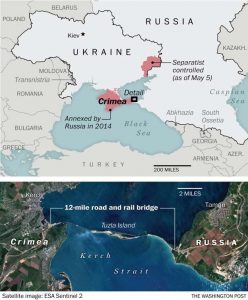

 © Provided by WP Company LLC d/b/a The Washington PostMOSCOW — President Vladimir Putin on Tuesday opened a $4 billion bridge directly linking Russia to Crimea, giving him a propaganda victory that drew condemnation from the West and served as the latest demonstration of his personalized system of power.
© Provided by WP Company LLC d/b/a The Washington PostMOSCOW — President Vladimir Putin on Tuesday opened a $4 billion bridge directly linking Russia to Crimea, giving him a propaganda victory that drew condemnation from the West and served as the latest demonstration of his personalized system of power.
Putin, clad in jeans and a jacket, walked on the Russian end of the 12-mile-long, four-lane bridge alongside the business mogul who built it — Arkady Rotenberg, the president’s former judo partner. Then Putin took the wheel and drove over the Kerch Strait of the Black Sea in an orange Kamaz dump truck — manufactured by a state-owned company headed by Sergey Chemezov, Putin’s KGB colleague in East Germany in the 1980s. Both Rotenberg and Chemezov are under U.S. sanctions.
Like many key moments of Putin’s presidency, it was a made-for-TV event designed to showcase his resolve and authority. State television broadcast live from a camera mounted inside the truck cab as Putin threw it into gear and made small talk with a construction worker sitting next to him. Kremlin spokesman Dmitry Peskov had earlier told journalists that Putin’s bridge project showed that “even the most ambitious plans can be realized when they are implemented by him.”
Putin annexed Crimea, a Ukrainian peninsula in the Black Sea, in 2014 after claiming that ethnic Russians in the region were threatened by the country’s pro-Western revolution. Starting Wednesday morning, up to 40,000 passenger cars a day will be able to cross the bridge, drastically reducing the time it takes Russians to reach Crimea, which until now was accessible from Russia only by plane or ferry.
Ukraine and the West slammed the bridge opening as illegal. The bridge, constructed without Kiev’s consent, “constitutes another violation of Ukraine’s sovereignty and territorial integrity by Russia,” an E.U. spokesman said in a statement. State Department spokeswoman Heather Nauert called on Russia not to impede passing ships bound for other parts of Ukraine.
“I am confident that the aggressor will not succeed and will bear responsibility in full,” Ukrainian President Petro Poroshenko said on Facebook, referring to Russia. “The invaders will need the bridge when they have to urgently leave our Crimea.”
The West and much of the rest of the world do not recognize the annexation as legitimate. But to many Russians, Putin’s “return” of the popular vacation destination remains his crowning achievement. In 1954, Soviet leader Nikita Khrushchev had transferred control of Crimea from Russia to Ukraine.
It also demonstrated, his supporters say, Putin’s uncompromising push to put Russian interests first and stand up to Western hegemony.
The bridge opening represented a milestone in Putin’s efforts to show the world — and his people — that the annexation of Crimea was irreversible. The bridge will open to truck traffic in the fall, and a railroad component is scheduled to open late next year. It has been eagerly anticipated by Crimeans as an economic lifeline to their now-isolated and sanctions-hit territory. On Tuesday, state television predicted that it would bring many new tourists and lower food prices to Crimea.
It also underscored the Putin-centric system of political and economic patronage in Russia. Rotenberg’s role as the builder of the bridge showed how Russia’s billionaires have been able to leverage their closeness to Putin to further enrich themselves — while also rendering services to the state.
Asked on state television whether international sanctions had interfered with the project, Rotenberg responded: “Those who wanted to interfere helped us instead. They made us more attentive and thoughtful. Well — probably they did create certain difficulties, but we’ve overcome them, and these difficulties made us unite.”
Russian media outlets have documented Putin’s close involvement in the project at length. When a worker at the site told him in March as cameras rolled that the roadway was slated to open by the end of this year, Putin responded: “Can it be done by May?”
“We’ll try,” the worker said.
“That would be great, so that people can use it in the summer season,” Putin said.
The focus on Putin’s role, however, also hinted at a less flattering reality: the untold number of poor roads, railroads and bridges across the country that don’t benefit from the president’s personal patronage. The World Bank ranks the quality of Russia’s trade and transport infrastructure at 94th in the world, just behind Tunisia and ahead of Colombia.
Across the country, Russians complain of corruption and poor execution hindering much-needed public works repairs and infrastructure projects. The government’s push to pour money into Crimea will mean even fewer funds for projects elsewhere, said Dmitry Oreshkin, a Moscow political analyst.
“No matter how many wrinkles Vladimir Putin has on his forehead and no matter how many hands he has, this model of manual leadership only works on so many projects,” Oreshkin said.
Natalia Abbakumova contributed to this report.
https://www.msn.com/en-us/news/world/putin-s-bridge-to-crimea-illustrates-his-power-and-his-regime-s-weak-spot/ar-AAxkbfN?ocid=ob-fb-enus-580



